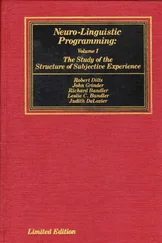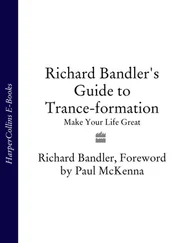1 could see rapid eye movement as his arm started down with unconscious movements, so I knew he was visualizing. I said "Hold it there. Can you see the Wookie?" He said "Urnhum."
"Ask him if he'll be on your side, and be your friend, and be there to help take care of you." 1 could see him move his mouth and lips as he asked the Wookie the question. When he came back, 1 asked "What did he say?" Dave said "I couldn't understand him; he just made a sound." If you saw Star Wars, you know that the Wookie's speech was unintelligible. So I said "OK, have him move his head up and down for 'yes' and sideways for 'no.' Ask him again." So Dave went back and asked, and the Wookie nodded his head "yes." I asked "Look, is the Wookie tough enough to handle these monsters?" He thought about it for a while and then said "I don't think so. They're even bigger and meaner than the Wookie is."
I said "But he's faster than the monsters, right?" Dave said "Yeah." I put my hand on Dave's shoulder and said "OK. The Wookie's going to be standing there, and you know he's going to be there for you because you'll feel the pressure on your shoulder as he stands next to you with his hand on your shoulder, knowing that if worse comes to worse, he'll sweep you up into his arms and run, because he can outrun the monsters. So you'll always be able to get away if you need to." He processed that and nodded.
"However, we haven't dealt with the monsters yet. Who else could do that?" We cast about for other possibilities, and he came up with the answer, as the client always does if the therapist is smart enough to arrange the context. He chose Godzilla.
I said "OK, go in and sec Godzilla." Dave closed his eyes immediately and raised his arm. It was one–trial learning; he understood exactly. I again saw rapid eye movements as he went inside and watched. Then he stopped and said "I'm having trouble getting an answer." I said "Well, watch his head." Dave said "But he's facing the other direction." "Tell him to turn around!" I said. So Dave went "Turn around."
Now that in itself was a very important change. He was now controlling powerful creatures in the domain in which he had been terrified. I was operating entirely within his belief system, his own metaphor.
Godzilla turned around and nodded "yes." I said "Now there's only one problem left. You've got someone to defend you and take care of the monsters if you need it. But Godzilla is big and clumsy. He's strong, and he'll take care of you, but you don't want him tromping around in dreams when you don't need him."
Listen to the presupposition in that statement. That statement said to him " You will have dreams. Some will have monsters and some won't. Godzilla will be appropriate in some dreams and in some he won't be." I was beginning to convert dreaming back into a normal, even enjoyable activity, rather than the time to have nightmares. At that point Dave told me that in the story about Godzilla, there's a kid who wears a special necklace. When this Kid wants Godzilla to arrive because he's being threatened by other monsters, all the kid does is touch the necklace. That's the signal for Godzilla to arrive.
I asked Dave's mother "Would you be willing to spend an hour this afternoon taking Dave around to some jewelry stores to find a necklace that will work for him as a signalling device?" I needed to be careful about over–all ecology here. In his town a little boy running around wearing a necklace wouldn't go over very well. I told him that he was only to wear it on evenings when he knew he would need it. Again, this was a way of putting the whole thing under his control.
In this example I didn't challenge the child's belief system; I didn't challenge the way he labeled things. I did no interpretation, but rather had the flexibility to enter into the child's world of beliefs. I then used devices within that world that were appropriate for getting the choices that the child needed at the time.
Man: What if the nightmares were just a symptom of something else?
All you know about when you work with an individual or family are the symptoms. My guess is that the nightmares did represent something going on within the family system, though I have no idea what. I asked Pam to keep a watch on the family to find out if any other symptoms emerged. Six months later she reported that there were no other symptoms. If other symptoms had emerged, I would go to reframing.
By responding to Dave's nightmares the way I did, I changed their meaning. In essence, I reframed them. The fact that I did this in the mother's presence was also important, because that changed her response to the nightmares. I gave her an example of a different way of responding to the nightmares.
Woman: Why did you use the dreaming arm technique?
It's just a game, and I wanted to begin with a game. With children, framing things as games produces a much more useful response than framing them as problem–solving. The dreaming arm is particularly useful in dealing with nightmares because it places visualization under the control of the child.
Man: You have about eight minutes for your benediction. I just thought you might like to know that.
You want us to put you into trance, huh? We decided not to do it this time, We were going to give you lots of post–hypnotic suggestions, but we decided we wanted to find out what would happen if we just left you hanging. We wanted to know if we could come back here next year and you'd all still be sitting here.
OK. During the course of the past three days you have gone through a whole variety of experiences and learnings. There, it feels much better already, doesn't it? Now take a few moments and think about the sequence of what has occurred here. Go back to the beginning—three days ago—and quickly run through and review internally the things you learned. What are the things you want to take with you when you go back to your office, your home, your family? … Because the learnings you had here in the Grand Ballroom could stay in the Grand Ballroom, but they won't if you notify yourself when and where you want them to go.
You see, learning can remain in one state of consciousness. State–conditioned learning is a fact. Once a group of medical students I worked with were given an examination in the same room in which they learned the material. Each one passed the exam beautifully. Five minutes after the exam, they were taken across the campus to the gymnasium and given the same examination. Seventy–five percent of them flunked it, because the learnings of their classroom were not always available in other contexts. And the learnings of the gymnasium weren't very useful in taking a medical exam.
This selective availability of information keeps your mind from being cluttered unnecessarily, but it can also prevent you from having learnings when and where you need them.
The best way to have a learning is to have it only when you need it. You see, if you constantly thought of your phone number all day long every day, you'd go crazy. If you can think of it whenever you want to, except when you are near a telephone, it doesn't work for you. If you try to understand why that's the case, you still won't be able to call home. But if you only think of it when you want to tell it to someone else, or to dial your home, it's a learning that serves you well.
So think of the things you want to take out of the Grand Ballroom
. . and think about the places you want to take them. . , . You don't have to think about what you are going to do with the learnings when you get there…. Just think about the furniture in your living room … the bed that you sleep in at night … that favorite office chair … your secretary … the carpet in the place where you work … the clients you've seen too many times … the business associates that you've always wanted to get … to do anything … that you want them to. Think about friends … and lovers . . , think about times and places … in your future … that are places worthy …of taking these learnings and understandings , . . and having them spontaneously emerge… .
Читать дальше











